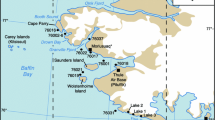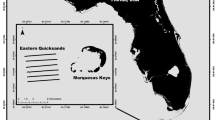Abstract
The U.S. Fish and Wildlife Service and Canadian Wildlife Service incorporate information from annual aerial and ground counts of waterfowl into harvest management strategies. Timing of population surveys is thought to be optimal for early nesting species but may not reliably reflect the status of species with later migration chronology. The purpose of this study was to evaluate effects of survey timing on diving duck and duck brood abundance indices in eastern South Dakota. Findings indicate that timing of aerial breeding surveys occurred too early in eastern South Dakota to accurately reflect diving duck population status because birds had not yet settled into breeding habitats and aerial production surveys did not coincide with peak duck brood abundance. Diving duck abundance from aerial surveys conducted during 10–17 May were higher than indices from ground surveys conducted 2 weeks later because lesser scaup (Aythya affinis), ring-necked duck (Aythya collaris), and bufflehead (Bucephala albeola) were still migrating through eastern South Dakota. Ground-survey estimates of redhead (Aythya americana) and canvasback (Aythya valisineria) abundance exceeded the upper limit of 95% confidence intervals for aerial survey estimates. Results from our second year of study showed an 11-fold decrease in lesser scaup abundance and an 8-fold decrease in ring-necked duck abundance in the two weeks following aerial breeding surveys. Brood abundance of dabbling and diving ducks peaked 1–1.5 months after aerial production surveys conducted in early July. Late-nesting indices calculated from aerial surveys were unrelated (P=0.21) to number of late-hatching broods, whereas number of broods hatching after aerial surveys was correlated with late-nesting indices from ground surveys (r2=0.74, P<0.01) and with number of July ponds (r2=0.77, P<0.01). We encourage scientists to initiate a more thorough evaluation of survey biases to ensure that trends accurately reflect status of duck populations and to explore the possibility of using a separate late May/early June aerial survey after diving ducks have settled into habitat as a way of assessing breeding population trends for these species.
Similar content being viewed by others
Literature cited
Anderson, M. E. 1956. A comparison of road and aerial duck brood census methods during three successive brood seasons. South Dakota Department of Game, Fish and Parks, Job Completion Report. Pierre, SD, USA.
Batt, B. D. J., M. G. Anderson, C. D. Anderson, and F. D. Caswell. 1989. The use of prairie potholes by North American ducks. p. 204–227. In A. G. van der Valk (ed.) Northern Prairie Wetlands. Iowa State University Press, Ames, IA, USA.
Caithamer, D. F. and J. A. Dubovsky. 1995. Waterfowl population status, 1995. U.S. Fish and Wildlife Service and Canadian Wildlife Service, Washington, DC, USA.
Caithamer, D. F. and J. A. Dubovsky. 1996. Waterfowl population status, 1996. U.S. Fish and Wildlife Service and Canadian Wildlife Service, Washington, DC, USA.
Cowardin, L. M. and R. J. Blohm. 1992. Breeding population inventories and measures of recruitment. p. 423–445. In B. D. J. Batt, A. D. Afton, M. G. Anderson, C. D. Ankney, D. H. Johnson, J. A. Kadlec, and G. L. Krapu (eds.) Ecology and Management of Breeding Waterfowl. University of Minnesota Press. Minneapolis, MN, USA.
Crissey, W. F. 1957. Forecasting waterfowl harvest by flyways. Transactions of the North American Wildlife Conference 22:256–268.
Gollop, J. B. and W. H. Marshall. 1954. A guide for aging duck broods in the field. Mississippi Flyway Council Technical Report, Minneapolis, MN, USA.
Hammak, J. and G. M. Brown, Jr. 1974. Waterfowl and wetlands: toward bioeconomic analysis. Resources for the Future, Inc., Washington, DC, USA.
Henny, C. J., D. R. Anderson, and R. S. Pospahala. 1972. Aerial surveys of waterfowl production in North America, 1955–1971. U. S. Fish and Wildlife Service, Washington, DC, USA. Special Scientific Report Wildlife 160.
Martin, F. W., R. S. Pospahala, and J. D. Nichols. 1979. Assessment and population management of North American migratory birds. p. 187–239. In J. Cairns, Jr., G. P. Patil, and W. E. Waters (eds.) Environmental Biomonitoring, Assessment, Prediction, and Management—Certain Case Studies and Related Quantitative Issues. International Cooperative Publishing House, Fairland, MD, USA.
Pospahala, R. S., D. R. Anderson, and C. J. Henny. 1974. Population ecology of the mallard. II. Breeding habitat conditions, size of the breeding population, and production indices. U. S. Fish and Wildlife Service, Washington, DC, USA. Resource Publication 115.
Ringleman, J. K. and L. D. Flake. 1980. Diurnal visibility and activity of blue-winged teal and mallard broods. Journal of Wildlife Management 44:822–829.
Smith, G. W. 1995. A critical review of the aerial and ground surveys of breeding waterfowl in North America. National Biological Service, Washington, DC, USA. Biological Science Report 5.
Stoudt, J. H. 1982. Habitat use and productivity of canvasbacks in southwestern Manitoba, 1961–1972. U.S. Department of the Interior, Fish and Wildlife Service, Washington, DC, USA. Resource Publication 99.
U. S. Fish and Wildlife Service and Canadian Wildlife Service. 1987. Standard operating procedures for aerial waterfowl breeding ground population and habitat surveys in North America. Office of Migratory Bird Management, Laurel, MD, USA.
Author information
Authors and Affiliations
Rights and permissions
About this article
Cite this article
Naugle, D.E., Johnson, R.R., Cooper, T.R. et al. Temporal distribution of waterfowl in eastern South Dakota: Implications for aerial surveys. Wetlands 20, 177–183 (2000). https://doi.org/10.1672/0277-5212(2000)020[0177:TDOWIE]2.0.CO;2
Received:
Revised:
Accepted:
Issue Date:
DOI: https://doi.org/10.1672/0277-5212(2000)020[0177:TDOWIE]2.0.CO;2




